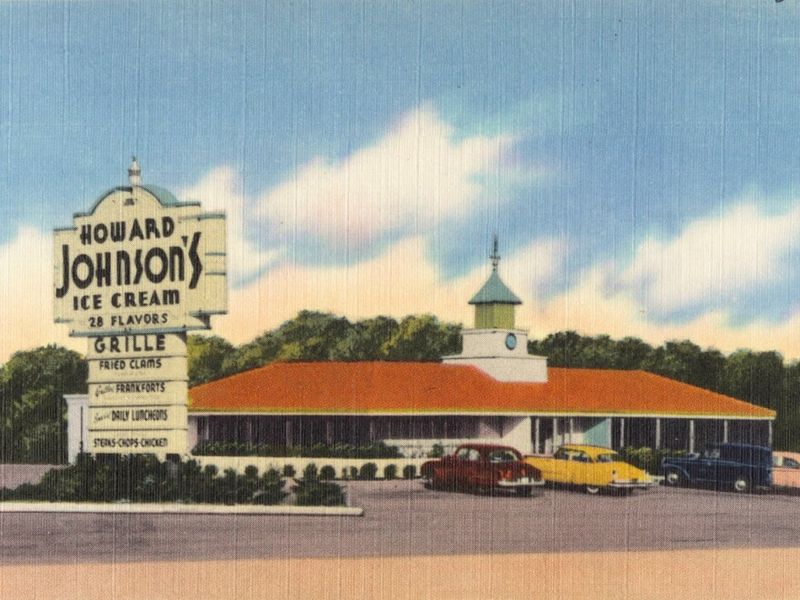20 Closed Restaurants Only Boomers Might Remember

Remember those restaurants where your family gathered for special occasions or after-school treats? The places with memorable mascots, signature dishes, and quirky decor that defined dining out in the 50s, 60s, and 70s?
Many beloved restaurant chains have disappeared from America’s landscape, leaving only memories and vintage photos. Join us for a nostalgic journey through 20 restaurant time capsules that Baby Boomers will surely recognize.
1. Howard Johnson’s

Those iconic orange roofs beckoned travelers across America’s highways for decades. The restaurant chain boasted 28 ice cream flavors long before Ben & Jerry’s made it cool to offer variety.
Families flocked to HoJo’s for their famous fried clams and macaroni and cheese. By the 1970s, Howard Johnson’s had become the largest restaurant chain in America with over 1,000 locations.
2. Sambo’s

Founded in 1957 by Sam Battistone and Newell Bohnett, this pancake house chain grew to a staggering 1,117 locations in its heyday. The controversial name and imagery eventually led to its downfall.
Regulars reminisce about their fluffy pancakes and affordable breakfast platters that rivaled IHOP. By 1982, all but the original Santa Barbara location had either closed or been converted to other restaurant brands.
3. Burger Chef

Once McDonald’s biggest competitor, Burger Chef pioneered the kids’ meal concept with their Fun Meal years before Happy Meals existed. Their flame-broiled burgers had a distinctive taste that many still crave today.
The chain’s mascots, Burger Chef and Jeff, delighted children nationwide. At its peak, Burger Chef operated 1,200 locations, but was eventually purchased by Hardee’s in 1982, causing this beloved burger joint to fade into fast-food history.
4. Red Barn

Nothing was more eye-catching than those bright red barn-shaped restaurants dotting American roadsides. The chain’s slogan “When the hungries hit, hit the Red Barn” stuck in everyone’s mind through catchy commercials.
Their signature Big Barney and Barnbuster burgers competed with the best in fast food. Kids especially loved the cartoon mascots – Hamburger Hungry, Chicken Hungry, and Big Fish Hungry – who appeared in advertisements and promotional materials throughout the 1970s.
5. Gino’s Hamburgers

Co-founded by Baltimore Colts football star Gino Marchetti in 1957, this sports-themed chain became a mid-Atlantic staple. Their Sirloiner sandwich and Kentucky Fried Chicken (they were early KFC franchisees) brought in hungry crowds.
The restaurants featured sports memorabilia and created a unique atmosphere that blended fast food with team spirit. Marriott Corporation purchased Gino’s in 1982, converting many locations to Roy Rogers restaurants and ending this beloved sports-food connection.
6. Wetson’s

New Yorkers of a certain age still get misty-eyed remembering Wetson’s fifteen-cent hamburgers. This regional chain went head-to-head with McDonald’s throughout the 1960s and early 70s in the New York metropolitan area.
Their yellow and white buildings featured a distinctive ‘W’ logo that became a familiar sight around the city. The Big W burger was their answer to the Big Mac, often inspiring fierce loyalty among local customers before the chain succumbed to larger competitors in 1975.
7. Valle’s Steak House

Long before Outback and Texas Roadhouse, Valle’s dominated the affordable steakhouse market across the Northeast. Founded in Portland, Maine in 1933, this family-owned chain expanded to 32 locations during its heyday.
Famous for massive dining rooms that could seat hundreds, Valle’s served quality steaks at reasonable prices. Their all-you-can-eat salad bars became legendary among hungry patrons before financial troubles led to the chain’s closure by the late 1980s.
8. Carrols

Before becoming Burger King’s largest franchisee, Carrols operated its own distinctive restaurant chain. Their mascot – a smiling redheaded girl with pigtails – adorned signs throughout the Northeast and parts of the Midwest.
The Club Burger stood out as their signature sandwich, competing with other fast-food giants of the era. Many Carrols locations were converted to Burger Kings in the 1970s, erasing this once-familiar brand from the American landscape while the company behind it continued to thrive.
9. Arthur Treacher’s Fish & Chips

Named after the British actor who became its spokesperson, this chain brought authentic-style fish and chips to America in 1969. Their batter-dipped fish and thick-cut chips served in a newspaper-lined basket created a distinctive dining experience.
The restaurants featured a British pub atmosphere complete with nautical decor. Though once boasting over 800 locations nationwide, competition and rising fish prices sank most Arthur Treacher’s ships, leaving only a handful of locations operating today under different ownership.
10. Steak and Ale

Pioneering the casual dining segment in 1966, Norman Brinker’s Steak and Ale introduced America to the salad bar concept. Their Tudor-style buildings with dark wood interiors created an upscale atmosphere at surprisingly affordable prices.
The chain became famous for their herb-roasted prime rib and Hawaiian chicken. At its peak, Steak and Ale operated over 280 locations before declining in the 1990s and finally closing completely when parent company Metromedia Restaurant Group filed for bankruptcy in 2008.
11. Victoria Station

Dining in converted railroad cars made Victoria Station a unique experience in the 1970s. This British-themed steakhouse chain created restaurants using authentic railroad boxcars and cabooses connected together.
The interiors featured railroad memorabilia, British phone booths, and servers in conductor-inspired uniforms.
Their prime rib and Yorkshire pudding attracted diners looking for something beyond the ordinary before financial mismanagement derailed the chain in the late 1980s.
12. Childs Restaurant

Long before chain restaurants dominated America, Childs pioneered the concept in 1889. Their white-tiled interiors with immaculate counters and uniformed servers set the standard for cleanliness in early 20th century dining.
Famous for their pancakes and affordable home-style meals, Childs grew to over 125 locations in the 1920s and 30s. The chain began declining after World War II, with the last restaurants operating under the Childs name closing by the mid-1960s.
13. Beefsteak Charlie’s

“I’ll feed you like there’s no tomorrow!” promised the commercials for this beloved New York-based chain. Their unlimited salad bar, bottomless shrimp, beer, wine, and sangria made them a popular destination for young adults and families alike.
Founded in 1976, the chain expanded rapidly to nearly 60 locations throughout the Northeast. Despite their all-you-can-eat popularity, the concept proved financially unsustainable, leading to the chain’s demise by the early 1990s.
14. Doggie Diner

Those giant dachshund heads sporting chef hats became iconic landmarks throughout the San Francisco Bay Area. Founded in 1948, this regional chain grew to 30 locations, delighting customers with quality hot dogs and fast-food basics.
The 7-foot fiberglass dog heads created by billboard designer Harold Bachman gave the chain instant recognition.
After changing ownership several times, the chain disappeared by the 1980s, though one restored dog head remains as a historical landmark in San Francisco.
15. Bennigan’s

The original Irish-themed casual dining experience brought potato skins and Monte Cristo sandwiches to suburban America in the 1970s. Founded by Norman Brinker (the same restaurant pioneer behind Steak and Ale), Bennigan’s created the fun “fern bar” atmosphere that defined casual dining.
Their extensive cocktail menu and desserts attracted after-work crowds. Though once operating over 300 locations, Bennigan’s parent company filed for bankruptcy in 2008, closing most restaurants, though a few franchised locations still operate today.
16. Chi-Chi’s

“A celebration of food!” was the slogan for this Mexican-themed restaurant chain that introduced middle America to chimichangas and fried ice cream. Founded in 1975 by former Green Bay Packers star Max McGee and restaurateur Marno McDermott, Chi-Chi’s expanded to over 210 locations.
Their festive atmosphere with colorful decor and signature margaritas created a party vibe. A devastating hepatitis A outbreak linked to green onions in 2003, combined with bankruptcy issues, ultimately led to the chain’s complete closure in the United States.
17. Minnie Pearl’s Chicken

Country comedian Minnie Pearl lent her name to this fried chicken chain that briefly rivaled Kentucky Fried Chicken in the late 1960s. Complete with restaurants sporting the character’s signature hat with a price tag dangling from it, the chain expanded rapidly to over 500 locations.
Unfortunately, poor quality control and financial mismanagement led to its spectacular collapse. The chain became notorious as an example of franchising gone wrong, with most locations closing by 1970 despite the beloved namesake’s popularity.
18. White Tower

Those gleaming white castle-like buildings with distinctive towers might trigger memories of 5-cent hamburgers for many Boomers. Founded in 1926, White Tower deliberately mimicked the success of White Castle, leading to a trademark infringement lawsuit.
At its peak, White Tower operated 230 locations, primarily in the Midwest and East Coast. Their small, square hamburgers served in spotlessly clean restaurants helped establish fast-food standards before the chain gradually disappeared in the 1970s.
19. Wimpy’s

“I’ll gladly pay you Tuesday for a hamburger today” – Popeye’s friend Wimpy inspired this burger chain that began in 1934 and once rivaled White Castle. Though never as widespread in America as overseas, Wimpy’s introduced many to the pleasures of the hamburger.
The casual diners featured counter service and table seating with affordable prices. While the American locations disappeared by the 1970s, the brand thrived internationally, particularly in the United Kingdom and South Africa, where Wimpy restaurants still operate today.
20. G.D. Ritzy’s

Combining 1950s nostalgia with quality ingredients, G.D. Ritzy’s served fresh-made burgers, hand-cut fries, and premium ice cream in an Art Deco atmosphere. Founded in 1980 by former Wendy’s executive Graydon Webb, the chain grew to 120 locations across the Midwest and South.
Their black and white checkered floors and chrome fixtures created a distinctive diner feel. Despite loyal customers who swore by their shoestring potatoes and fresh-scooped ice cream, financial troubles reduced the chain to just a few locations by the 1990s, with a small revival in Ohio.
